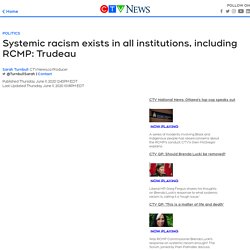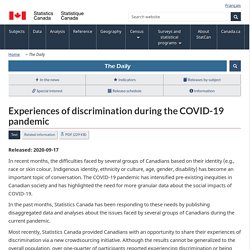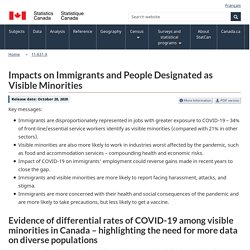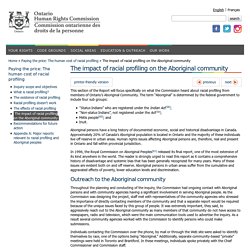

Racism in health care is 'a real thing,' says Indigenous physician. The president of the Indigenous Physicians Association of Canada says racism in health care can have 'very real and sometimes negative' consequences.

Recently, an Inuvialuit woman from Aklavik, N.W.T., said her uncle died from the effects of a stroke after health care staff mistook the signs of the stroke for drunkenness. Inuvialuit woman says uncle's stroke mistaken for drunkenness Dr. Health Canada knew of massive gaps in First Nations child health care, documents show. Health Canada officials were sent scrambling after a landmark human rights ruling last year that found the federal government discriminated against First Nation children by underfunding services for First Nation children, according to internal correspondence provided to CBC News.

The Health Canada documents reveal the department knew it faced serious shortfalls in the level of health services provided to First Nations children and was unprepared to implement changes prescribed by the human rights ruling. Creating conditions for Canadian aboriginal health equity: the promise of healthy public policy. Systemic racism exists in all institutions, including RCMP: Trudeau. OTTAWA -- Prime Minister Justin Trudeau says while it’s uncomfortable to admit and challenging to identify, there is systemic racism in all systems that govern the country, including Canada’s national police force.

Hours after Trudeau’s comments, disturbing new dash-cam footage emerged showing two RCMP officers violently arrest a First Nations Chief in Alberta over an expired licence plate tag on his truck. The footage, released Thursday, shows an officer run and tackle Fort Chipewyan First Nation Chief Allan Adam in an incident that the RCMP initially said required no further investigation. In the video, Allan steps out of a pickup truck and, within five seconds, is tackled to the ground by an officer, who shoves his elbow into Allan’s neck and punches him in the back of the head. "F--k you, don't resist arrest! " the officer yells. Initially the RCMP said the officers' actions were reasonable and did not meet the threshold for an investigation. "Right now it’s a program. From risk to resilience: An equity approach to COVID-19 – The Chief Public Health Officer of Canada’s Report on the State of Public Health in Canada 2020.
Chief Public Health Officer of Canada's Report on the State of Public Health in Canada 2020 Table of contents Message from the Chief Public Health Officer of Canada The COVID-19 pandemic is having a profound impact on the health, social and economic well-being of people in Canada and around the globe.

It has led to fundamental changes in our daily lives. WHO issues best practices for naming new human infectious diseases. WHO today called on scientists, national authorities and the media to follow best practices in naming new human infectious diseases to minimize unnecessary negative effects on nations, economies and people.

“In recent years, several new human infectious diseases have emerged. The use of names such as ‘swine flu’ and ‘Middle East Respiratory Syndrome’ has had unintended negative impacts by stigmatizing certain communities or economic sectors,” says Dr Keiji Fukuda, Assistant Director-General for Health Security, WHO. “This may seem like a trivial issue to some, but disease names really do matter to the people who are directly affected. We’ve seen certain disease names provoke a backlash against members of particular religious or ethnic communities, create unjustified barriers to travel, commerce and trade, and trigger needless slaughtering of food animals. The Daily — Experiences of discrimination during the COVID-19 pandemic. Released: 2020-09-17 In recent months, the difficulties faced by several groups of Canadians based on their identity (e.g., race or skin colour, Indigenous identity, ethnicity or culture, age, gender, disability) has become an important topic of conversation.

The COVID-19 pandemic has intensified pre-existing inequities in Canadian society and has highlighted the need for more granular data about the social impacts of COVID-19. In the past months, Statistics Canada has been responding to these needs by publishing disaggregated data and analyses about the issues faced by several groups of Canadians during the current pandemic. Most recently, Statistics Canada provided Canadians with an opportunity to share their experiences of discrimination via a new crowdsourcing initiative. Although the results cannot be generalized to the overall population, over one-quarter of participants reported experiencing discrimination or being treated unfairly over the course of the pandemic.
Impacts of COVID-19 on immigrants and people designated as visible minorities. Key messages: Immigrants are disproportionately represented in jobs with greater exposure to COVID-19 – 34% of front-line/essential service workers identify as visible minorities (compared with 21% in other sectors).

Visible minorities are also more likely to work in industries worst affected by the pandemic, such as food and accommodation services – compounding health and economic risks. Impact of COVID-19 on immigrants' employment could reverse gains made in recent years to close the gap. Immigrants and visible minorities are more likely to report facing harassment, attacks, and stigma. Immigrants are more concerned with their health and social consequences of the pandemic and are more likely to take precautions, but less likely to get a vaccine. TIMELINE: This is Canada's history of anti-Asian racism that COVID-19 has amplified. 8 Dead in Atlanta Spa Shootings, With Fears of Anti-Asian Bias.
Video transcript Police Search for Motive in Atlanta Spa Shootings The Atlanta police said a 21-year-old man was arrested and charged in the fatal shootings that took place at three massage parlors Tuesday night.

“This was a tragic day with many victims, but thankfully the suspect was quickly apprehended.” “The suspect did take responsibility for the shootings. ACWORTH, Ga. — The man who police say went on a rampage at three spas in the Atlanta area, killing eight people, was charged on Wednesday with eight counts of murder in connection with the attacks. Protesters Gather in Atlanta to #StopAsianHate. ATLANTA — After a week of pain, fear and mourning, Georgia’s capital city hosted a downtown march and rally on Saturday to protest the killing of eight people, six of them women of Asian descent, by a gunman who targeted three Atlanta-area massage businesses.

Hundreds of activists chanted, “Stop Asian hate,” as they departed Woodruff Park in downtown Atlanta, bound for the State Capitol, where they would link up with hundreds more for a rally in the wake of a shooting spree that left eight people dead. The roaming demonstration kicked off after a series of speeches and tracked along downtown sidewalks, past movie sets and the transit station. Bobbing picket signs and using megaphones, activists shouted messages like, “Asians are not a virus.” The protest was billed as a #StopAsianHate event that would allow people to “come together to grieve, heal and support.”
Senator Raphael Warnock said, “We need reasonable gun reform.” Ms. This is Ms. Ms. Mr. For Ms. More than a health crisis: Exploring Chinese stigma and the social impacts of COVID-19 - CIHR. The impact of racial profiling on the Aboriginal community. This section of the Report will focus specifically on what the Commission heard about racial profiling from members of Ontario’s Aboriginal Community.

The term “Aboriginal” is determined by the federal government to include four sub groups: “Status Indians” who are registered under the Indian Act[58]; “Non-status Indians”, not registered under the Act[59]; Métis people[60]; and Inuit. Youtube. Indigenous woman records slurs, taunts of Quebec hospital staff before her death. Joyce Echaquan was seeking medical help in a Quebec hospital room when she went live on Facebook, sharing her screams of pain and the verbal abuse she heard in the final moments of her life.
The death of the 37-year-old mother of seven from the Atikamekw nation of Manawan has drawn calls to confront systemic racism in health care across the country. Ms. Echaquan died on Monday at a hospital in Joliette, about 70 kilometres northeast of Montreal. She sought treatment for stomach pain last week, and was given morphine on Monday, although she had warned staff she had a heart condition and a pacemaker and could not handle the drug, a cousin, Mirella Dubé, said in an interview via Facebook. In the seven-minute live-streamed video, Ms. Canada Outraged by Death of Indigenous Woman Joyce Echaquan. Indigenous Care & Services - Hamilton Health Sciences. HHS has collaborated with Indigenous leaders and artists to create Signs of Welcome displayed at our sites.
Each sign features an image from a local Indigenous artist and includes the opening sentence of HHS’ land acknowledgement statement. Elder with Smudge Bowl The image of an Elder with a smudge bowl and eagle feather has been adapted by artist Jay Havens from the mural he created for Makayla’s Room at McMaster Children’s Hospital. Jay Havens is a multi-disciplinary artist of Haudenosaunee-Mohawk and Scottish-Canadian ancestry and a proud member of the Six Nations of the Grand River, Mohawk Bear Clan. Moccasin Images The image of three moccasins is adapted from artwork created by Philip Cote for the Moccasin Identifier Project, founded by Carolyn King, former elected Chief of the Mississaugas of the Credit First Nation.
Alliance for Healthier Communities. What are Aboriginal Health Access Centres Aboriginal Health Access Centres (AHACs) are Aboriginal community-led, primary health care organizations. They provide a combination of traditional healing, primary care, cultural programs, health promotion programs, community development initiatives, and social support services to First Nations, Métis and Inuit communities. There are currently ten AHACs in Ontario, providing services both on and off-reserve, in urban, rural and northern locations. First announced in 1995, AHACs were closely modelled after Ontario’s Community Health Centres (CHCs), whose wide basket of services and supports had become the preferred mechanism to improve the health and well-being of communities in Ontario facing various barriers in accessing health care. In fact, two CHCs had already been established, one in Toronto and another in Timmins, with a mandate to apply this CHC model as the framework for services to local Aboriginal community members.
Resources. Indigenous health backgrounder. Indigenous Healing and Wellness Strategy. About the Indigenous Healing and Wellness Strategy Ontario promotes improved health and wellness in Indigenous communities through Indigenous-led programs and services such as the Indigenous Healing and Wellness Strategy. The Indigenous Healing and Wellness Strategy reflects a shared commitment between the Ontario government and First Nations, Métis, Inuit and urban Indigenous partners to reduce family violence and violence against Indigenous women and children, and improve Indigenous healing, health and wellness through a continuum of culturally appropriate and Indigenous-designed and delivered programs and services.
The strategy combines traditional and mainstream approaches to program and service delivery. These community-based programs and services are available to Indigenous peoples living in First Nations and in urban and rural communities. They include: Three ministries fund the strategy: Ch9 care for indigenous peoples ohs. Statistics on Indigenous peoples. Institute of Indigenous Peoples' Health - CIHR. Indigenous Health. First Nations, Inuit and Métis are diverse populations whose health is affected by all social determinants of health, as well as a complex history of colonialism, racism, and residential schools.
Social determinants have a significant impact on disease and recovery experiences within these communities. CNA works to advance Indigenous health and nursing through its partnership accord with the Canadian Indigenous Nurses Association (CINA) and through its Canadian Network of Nursing Specialties. CNA is a supporter of Jordan’s Principle [PDF, 131.8 KB] and Shannen’s Dream [PDF, 41.6 KB], campaigns that address inequities in health, social and education services provided to aboriginal children. NCCIH - National Collaborating Centre for Indigenous Health > Home. Closing the Gaps in Aboriginal Health (ARCHIVED) - Government of Canada website outlining the research of the First Nations and Inuit Health Branch (FNIHB)
Government of Canada - Indigenous Health: Curated governmental links for available resources for the Indigenous communities. Canadian Indigenous Nurses Association.